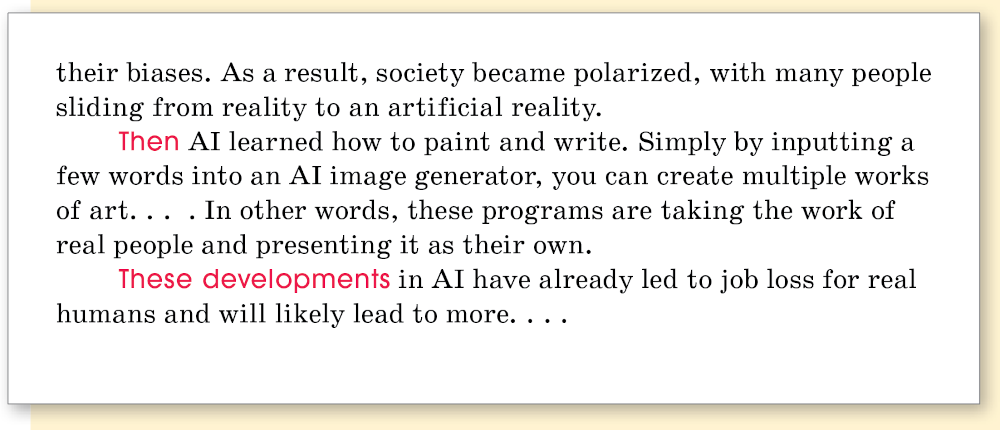WOC 103
Page 103
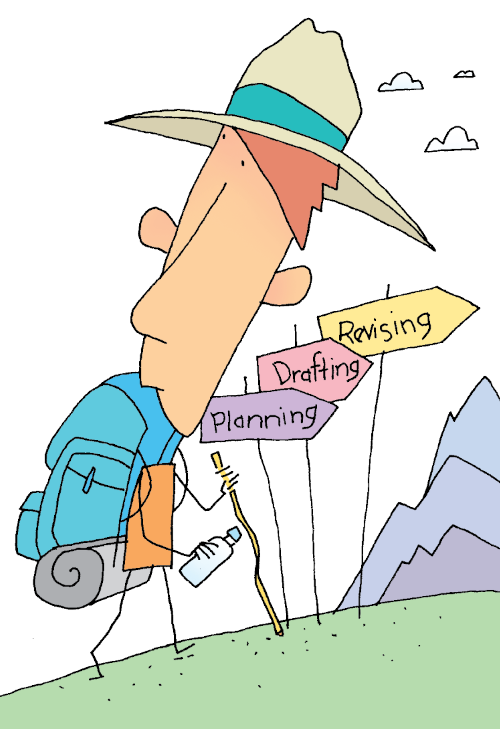
Writing Essays
Writing is a journey. When you start out, you might have no idea where you want to go or how to get there. So, you plan. Then you follow your plan, creating a first draft. Afterward, you take a look back to see how far you’ve come. (Revise means “look at again.”) You make adjustments—adding to your itinerary, reworking parts of your trip, discarding dead ends. When you finish, you have an amazing voyage of discovery that began with a few faltering steps.
In school, the vehicle for your journey is probably an essay. Essays usually start with a paragraph that gets the reader’s attention and introduces the topic. The middle part provides information about the topic, and the final paragraph sums up the ideas. Sound familiar? That’s because an essay is just a paragraph taken a few steps farther.
What’s Ahead
WOC 104
Page 104
Understanding Essays
You can say much more in an essay than you can in a paragraph because an essay contains many paragraphs. This chart shows how the parts of a paragraph relate to the parts of an essay.

From a Paragraph to an Essay
The examples on these two pages shows how a paragraph about artificial intelligence compares to an essay on the same topic.
Paragraph
Topic Sentence Artificial intelligence (AI) may soon be able to do everything that human intelligence can.Body Since the 1970s, computers have been able to run calculations in seconds that would take humans days to do. But we told ourselves that computers had to be programmed, that they would never be able to learn. Well, now they can. They can learn not only the best way to route traffic around an accident, but also how to paint pictures or write novels. Already, many people have lost their jobs to AI. What will happen when AI can do everything humans can do? Alan Turing, the father of computers, said that when we can’t tell a computer from a person, we must accept the computer as a person. Closing Sentence What will we do when we are no longer the smartest beings on planet Earth?
Good Thinking
Each paragraph in an essay must (1) stand on its own as a meaningful unit of thought and (2) connect to the paragraphs that come before and after it.
WOC 105
Page 105
AI and the Future of the Human Race
Beginning Paragraph Computer programmers started developing artificial intelligence (AI) in the 1950s. It took 50 years to create Deep Blue, a program that could beat grandmaster Garry Kasparov at chess. It took another 14 years to develop Watson, which defeated Ken Jennings at Jeopardy. Thesis Statement AI may soon be able to do everything that human intelligence can do.
In the early days of AI, computers had to be programmed by humans, but now they can learn for themselves. Programs start with preferences—situation they want to bring about and those they want to avoid, ranked by desirability. Programs then make decisions and learn from their mistakes. They become progressively better at achieving their goals.
Middle Paragraphs This sort of computer learning, when coupled with social media, led to deep societal consequences. Social media algorithms had the goal of keeping users using. They quickly learned what each user was interested in and presented only information that confirmed the user’s biases. They also learned that people responded to conspiracy theories that confirmed their biases. As a result, society became polarized, with many people sliding from reality to an artificial reality.
Then AI learned how to paint and write. Simply by inputting a few words into an AI image generator, you can create multiple works of art. Simply by providing a writing prompt to a chat-bot, you can output an essay or report or even a scientific paper written by AI. The problem is that the images are cribbed from thousands of images created by real artists, and the papers from real writing by real people. In other words, these programs are taking the work of real people and presenting it as their own.
These developments in AI have already led to job loss for real humans and will likely lead to more. The Organization for Economic Cooperation and Development predicts only a 9 percent job loss, but Michael Osborne and Carl Benedikt Frey say 47 percent of jobs are at risk. AI may do to middle-class jobs what steam power did to working-class jobs.
Ending Paragraph Alan Turing, founder of computer science, said that if we cannot tell if a computer is a person, we must treat the computer as a person. Stephen Hawking, the noted physicist, warned that doing so could “spell the end of the human race.” Whether optimistic or pessimistic about AI, most experts recognize we are already in uncharted territory. Soon, AI may be smarter than we are. The question is, what should we do now to prepare?
WOC 106
Page 106
Writing Guidelines
Use these guidelines whenever you have a question about selecting a topic, forming a thesis statement, and so on.
Prewriting ■ Selecting a Topic
Make sure you understand the writing assignment by using the PAST strategy. (See page 30.)
- What is your Purpose?
- Who is your Audience?
- What is your Subject?
- What Type of writing is it?
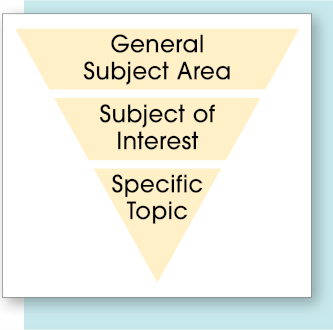
From General to Specific
This graphic shows how the selecting process should work. In most cases, your teacher will provide a general subject. It’s your job to narrow the subject down until you identify a specific topic that is appropriate for the assignment.
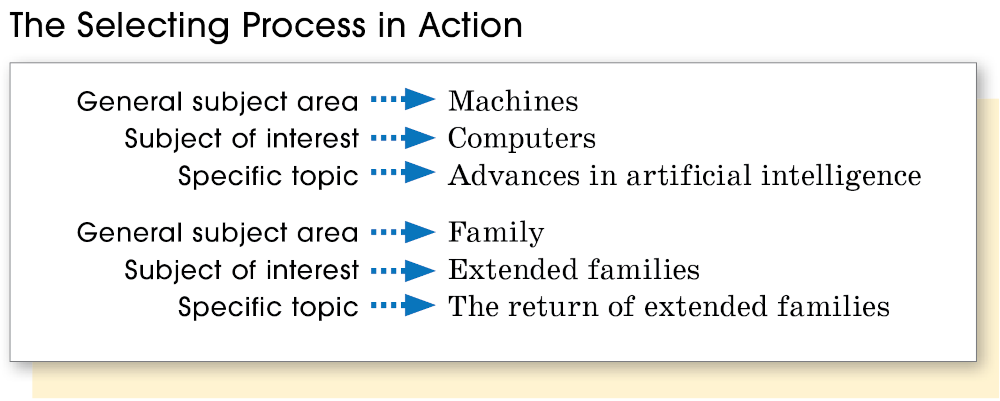
Good Thinking
Make sure your topic is neither too general nor too specific. For example, artificial intelligence is too general for an essay, while using the back button is too specific. A topic such as advances in artificial intelligence has the right depth.
WOC 107
Page 107
Gathering Details
Once you select a specific topic, your next job is to collect facts and details about it. Start by freewriting or listing to see what you already know about your topic. Then talk with other people and explore the Internet, books, magazines, and newspapers for information. Remember to use sources that are reliable and accurate. (See pages 354–355.)
Using Graphic Organizers
Use these graphic organizers to help collect and organize the details that you will use in your writing.
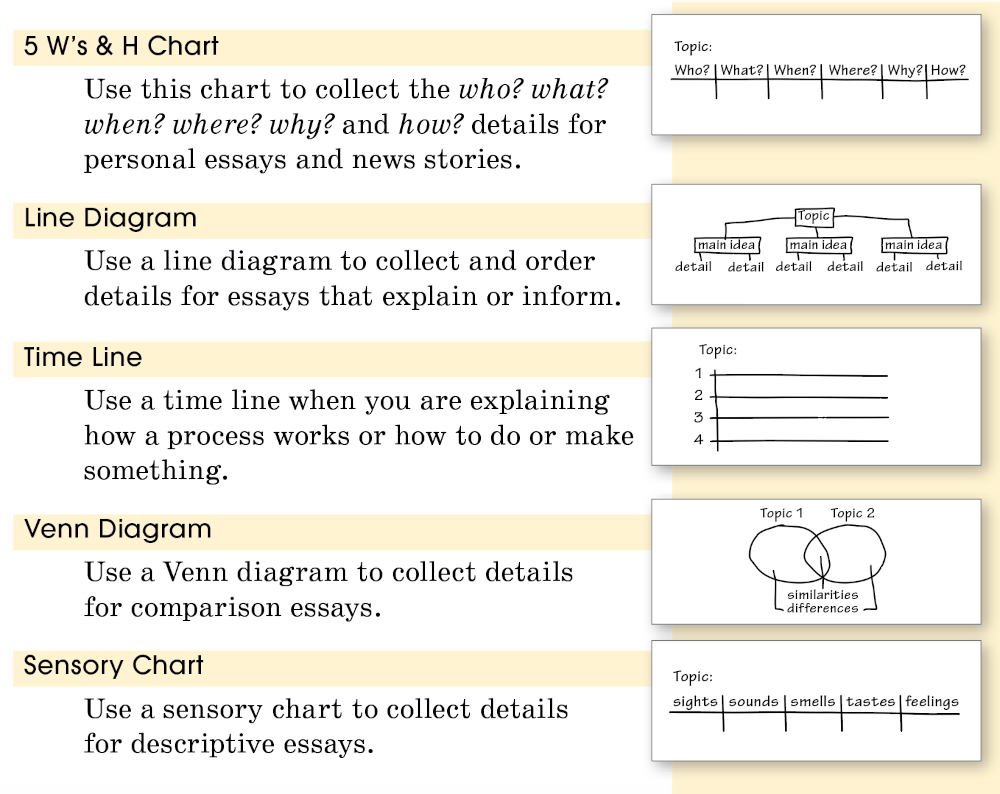
Helpful Hint
See “The Forms of Writing” section in this book for more specialized graphic organizers. For example, page 204 includes a “Best-Worst Chart,” which you can use when building an argument essay.
WOC 108
Page 108
Prewriting ■ Writing a Thesis Statement
After you collect details about your topic, you should be ready to form a thesis statement for your essay.
Using a Formula
A thesis statement usually expresses a specific thought or feeling about the topic. Use the following formula to form thesis statements:

Thesis Statements
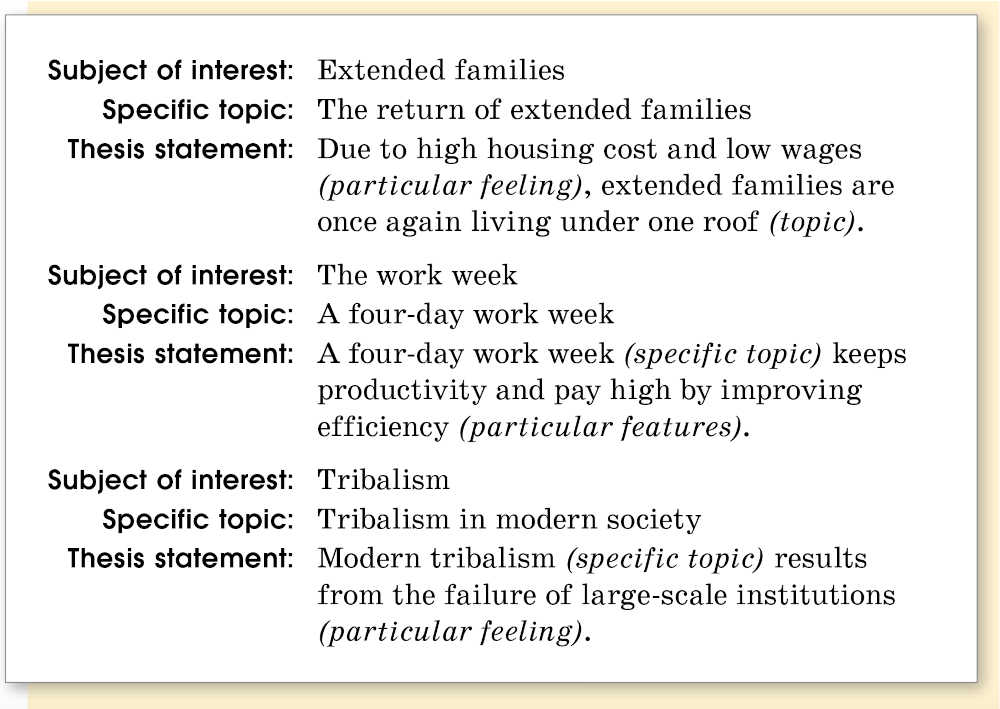
WOC 109
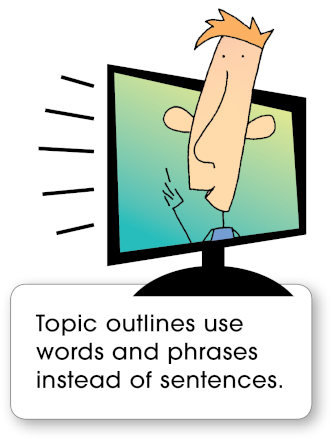
Page 109
Organizing Your Information
With a thesis statement in place, you’re almost ready to write. But first you need to organize the details for your middle paragraphs. (See page 111.)
Using an Outline
You can use a list, a line diagram, or an outline to organize your ideas. In an outline, you arrange details using Roman numerals, capital letters, and so on.
Sentence Outline
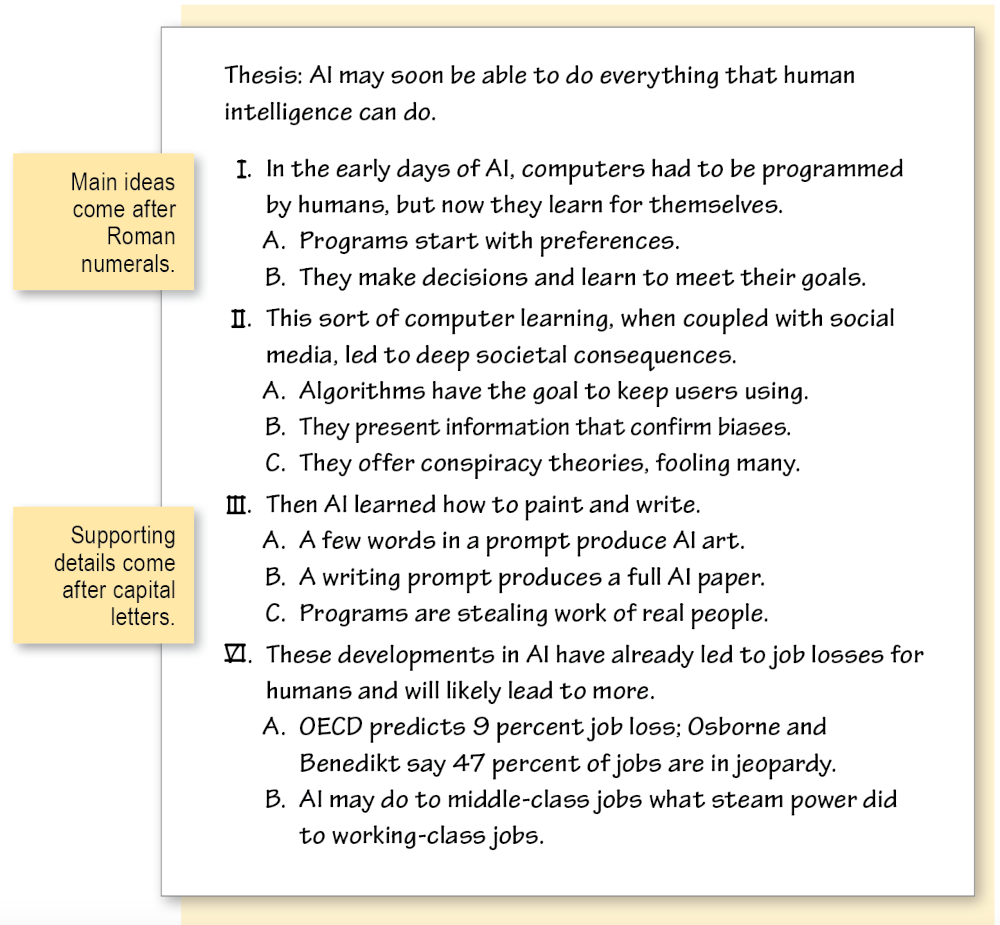

WOC 110
Page 110
Writing ■ Creating Great Beginnings
The beginning paragraph of an essay should grab the reader’s attention, introduce the topic, and state your thesis. To grab your reader’s attention, try one of these strategies:
- Start with an interesting or surprising fact.
About 48 percent of Americans aged 18–29 years are living with their parents, more than in 1940.
- Ask an interesting question.
Would you be able to do five days of work in four days?
- Open with a thought-provoking quotation.
Oliver Markus Malloy said, ”Tribalism is the gateway to racism.”
- Provide a brief history. (See the first sentence below.)
Using a Beginning Strategy
Use this strategy for strong opening paragraphs.

Helpful Hint
This strategy shows one way to write a beginning. For additional ideas, review other essays in this book.
WOC 111
Page 111
Developing the Middle Part
The middle paragraphs provide information that supports or develops the thesis. These paragraphs should be arranged according to your planning. You should use a pattern of organization that fits the topic and purpose of your essay.
Patterns of Organization
- Chronological order: This method of organization works well when you are presenting information that is time based.
- Order of importance: This method of organization works well when you are arguing for or against something. Writers often save their most important point for last.
- Logical order: This method of organization works well when you are informing your reader. (See the example below.)
- Spatial order: This method works well when you are trying to describe something: top to bottom, left to right, and so on.
Middle Paragraphs
Use your outline as an organizing guide. Each middle paragraph should cover one main point (II) and supporting details (A, B, C).

Helpful Hint
The outline lists just key details. The writer expands these details with additional facts. (See page 105.)
WOC 112
Page 112
Writing ■ Integrating Quotations
Quotations, the exact words of other people, especially authorities or experts, can provide an effective level of support in your writing. Choose quotations that reinforce or enhance your ideas about a topic. Use quotation marks to set off exact words of others.
Guidelines for Using Quotations
- Use quotations to lend authority to your writing.
Neuropsychologist Paul Pearsall notes, “Our most basic instinct is not for survival but for family. Most of us would give our own life for the survival of a family member, yet we lead our daily life too often as if we take our family for granted.” The return of the extended family helps renew these powerful ties.
- Use quotations that are clear and to the point.
Tim Ferris, author of The 4-Hour Workweek, explains the gained efficiency this way: “Being busy is a form of laziness. Doing less is the path of the productive.” Work tends to fill the time allotted for it, so shortening the time makes work more efficient.
- Use quotations to support your own thoughts.
Tribalism has caused gridlock in Washington. As Ben Carson stated, “If Americans simply choose to vote for a person who has a D or an R by their name, we will get what we deserve, which is what we have now.” A system based on compromise cannot function if there is no common ground between tribes.
Avoiding Quotation Problems
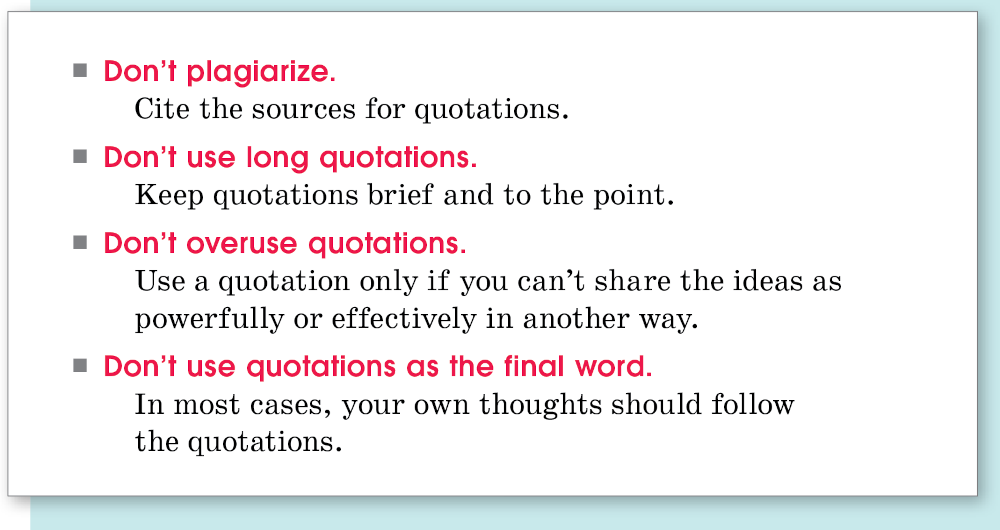
WOC 113
Page 113
Writing Great Endings
A closing paragraph typically revisits the thesis and leaves the reader with a thoughtful final idea. Consider the following strategies for writing your closing.
- Review your main points.
- Emphasize the special importance of one main point.
- Tie up any loose ends.
- Draw a conclusion and put the information in perspective.
- Present one last idea that solidifies your thesis.
Using an Ending Strategy
If you have trouble coming up with an effective closing paragraph, follow this step-by-step example.

Helpful Hint
This strategy shows one way to write a closing paragraph. For additional ideas, review other essays in this book.
WOC 114
Page 114
Revising ■ and Editing ■ Improving the Writing
Provided below are two key revising tips that you can apply to any essay-writing situation. (For help with revising and editing specific types of essays, see specific essays in this book.)
Ideas ■ Include Completing Details
If your essay does not provide clear and complete explanations, you may have to add more details. Notice how the new detail (in red) complete the explanation about the algorithms’ societal effects.
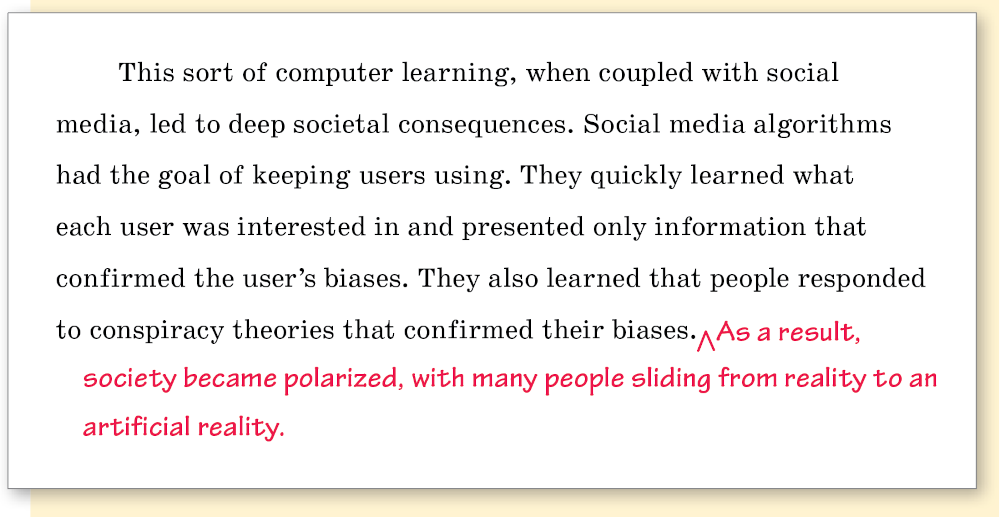
Organization ■ Connecting Paragraphs
If your essay does not read smoothly from paragraph to paragraph, you may need to add transitions and key words. In the following excerpt, the words in red show the connections in ideas.
